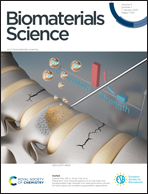Local epidermal growth factor delivery using nanopillared chitosan–gelatin films for melanogenesis and wound healing†
Abstract
Epidermal growth factor (EGF) is required for various regulations of skin tissue including wound healing; however, it has limited stability due to the physicochemical conditions of the wound milieu. The lack of functional EGF within the wound can cause permanent tissue defects and therefore, current wound patch designs involve EGF-releasing components. Consequently, the focus of such systems is to improve the wound healing mechanism, with minimal attention on melanogenesis of the scar tissue. The present study investigates in vitro/in vivo wound healing and melanogenesis potential of the EGF-doped films comprised of arrays of chitosan:gelatin nanopillars (nano C:G films) prepared by using nanoporous anodic alumina molds. The potential of EGF-doped films in wound healing was examined with individual and coculture systems of fibroblasts and melanocytes to mimic the wound conditions. The outcomes demonstrated that compared to the control groups, the combination of EGF doping and nanotopography consistently provided the highest levels of melanogenic activity-related genes, melanin contents as well as EGFR expressions for both melanocyte-only and coculture setups. Proteomic, genomic and histological analysis of the excisional wound model further demonstrated that if EGF was present within the nanostructured films, the performance of these substrates in terms of wound closure, collagen thickness as well as melanin deposition was considerably improved. Furthermore, when compared with the control saline treatment and healthy mice groups, significant differences for such parameters were obtained for the nano C:G films, irrespective of their EGF contents. Overall, the results indicate that EGF-doped nano C:G films are good candidates as wound patches that not only provide desirable healing characteristics but also cause improved melanogenic outputs.



 Please wait while we load your content...
Please wait while we load your content...